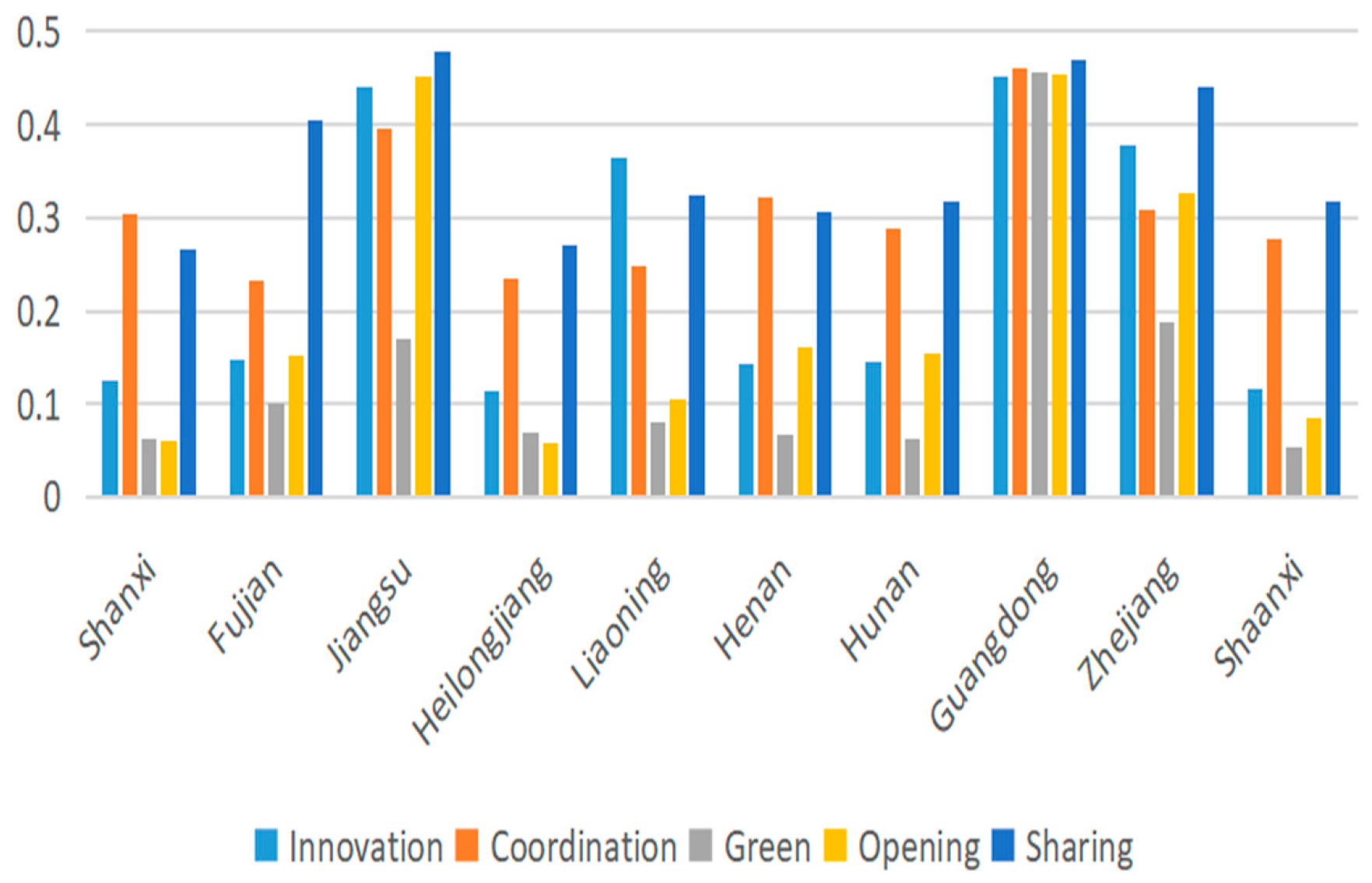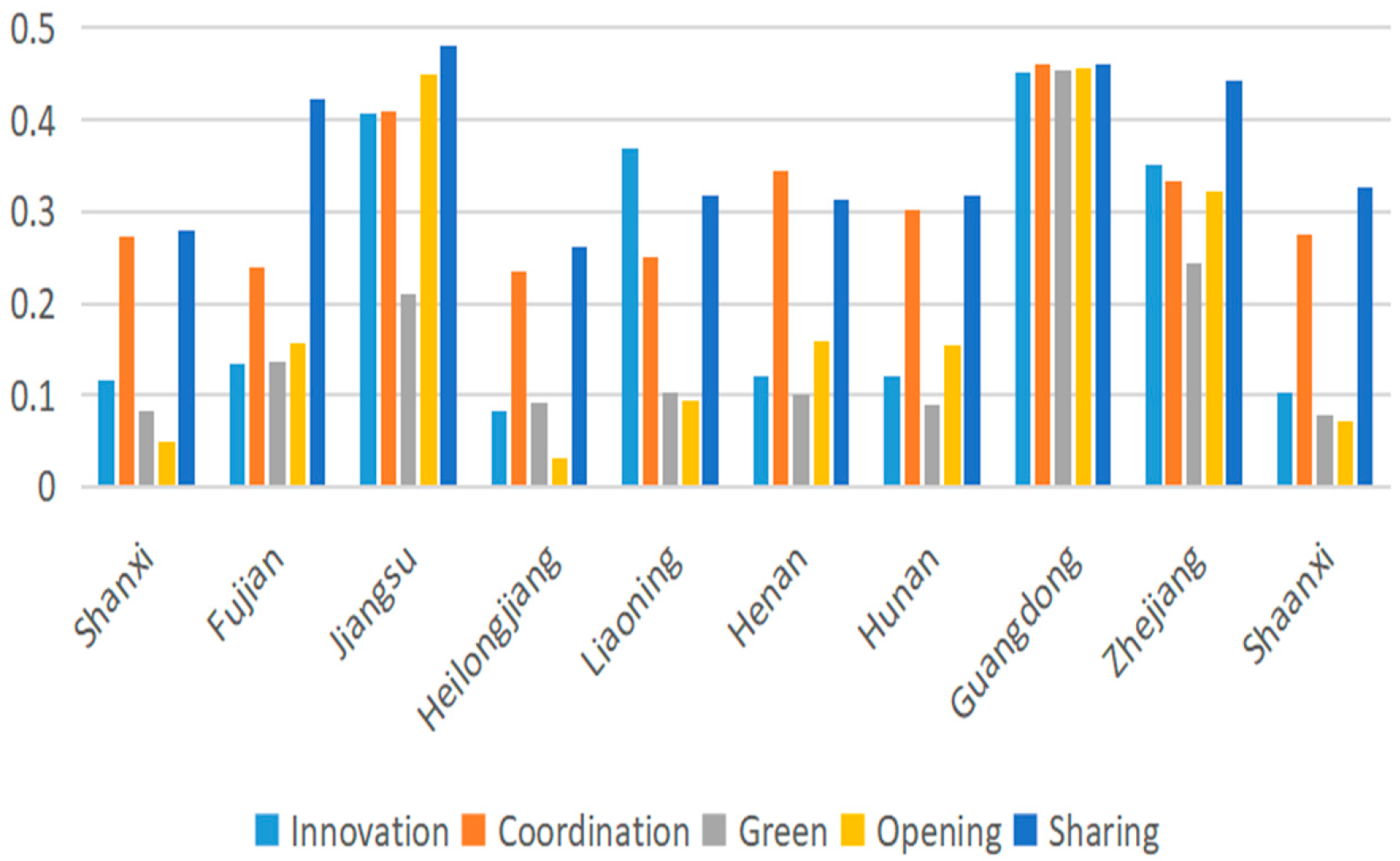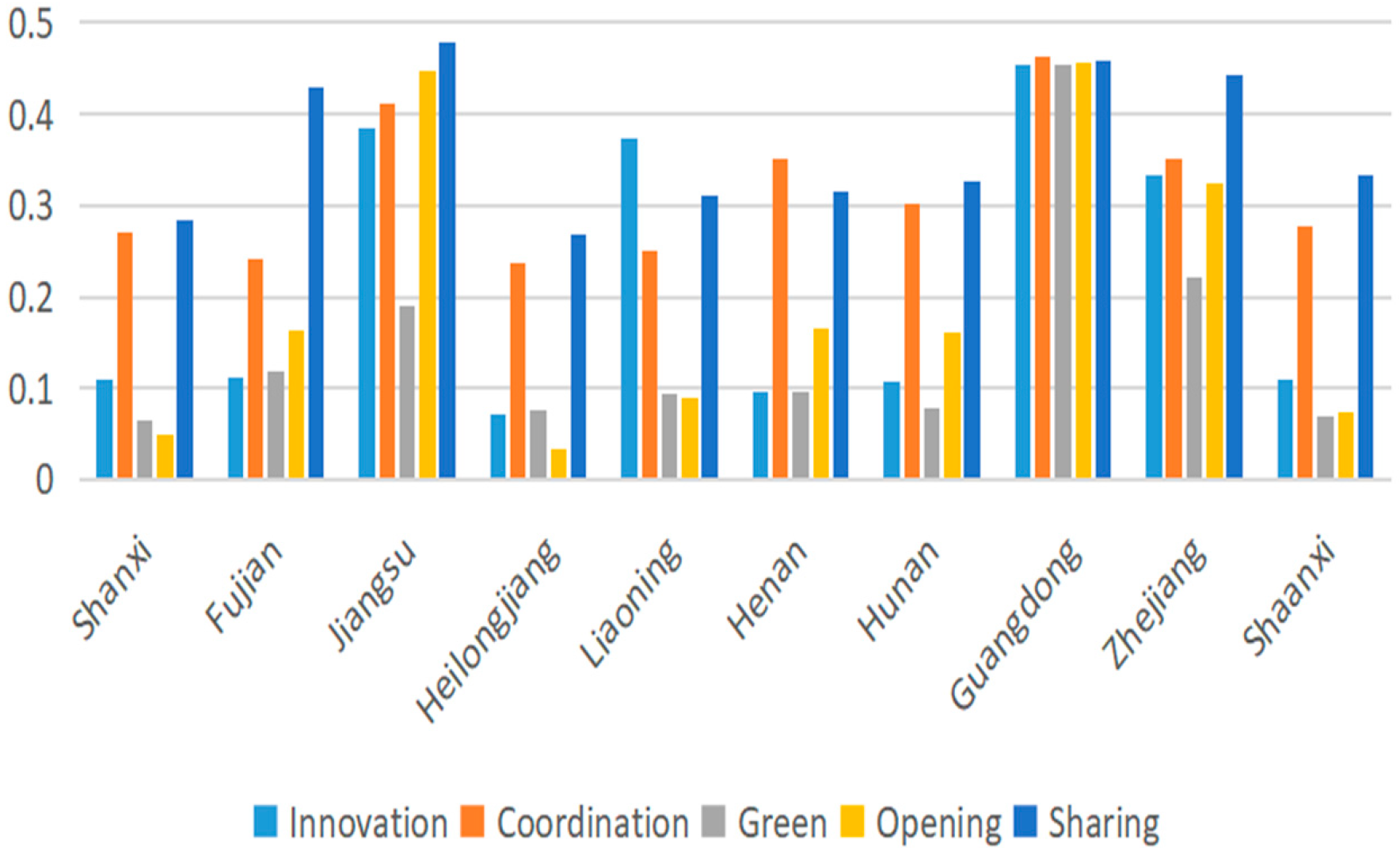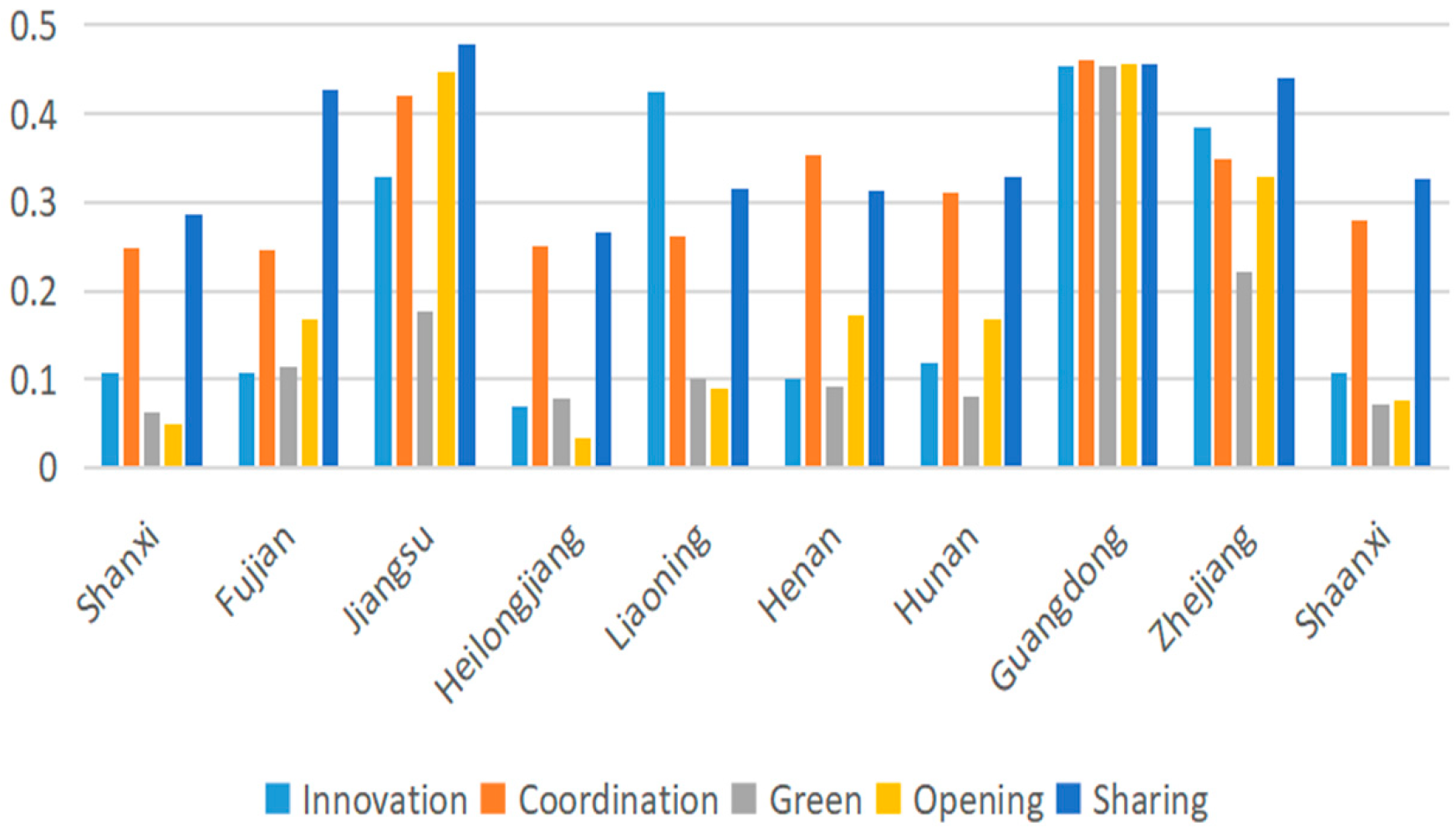A Comprehensive Evaluation and Empirical Research on Dual Carbon Emission Reduction under Digital Empowerment
Abstract
1. Introduction
2. Materials and Methods
2.1. Realization of the Connotation of Carbon Neutral Development Goal
2.2. Carbon Neutralization Evaluation Index Feature Extraction
2.3. Construction of Carbon Neutralization Evaluation Indicator System
2.4. Design of Carbon Neutralization Research Method
- (1)
- The weight of each index is calculated by entropy weight method.
- (a)
- Calculating information entropy :where m denotes the number of indicators.
- (b)
- Calculate the weight of each index :
- (2)
- On the other hand, the weight is calculated by the analytic hierarchy process, and the degree of each index is scored by experts. In this paper, SPSSPRO software is used to pass the consistency test of the judgment matrix and obtain the weight of the index .
- (3)
- The combination weight is solved by the comprehensive integration assignment method. The comprehensive integration weighting method is a commonly used method of comprehensive evaluation, which combines the characteristics of the subjective weighting method and objective weighting method to determine the index weight coefficient. There are also the addition integration weighting method and the multiplication integration weighting method. In this paper, we use the multiplication integration weighting method and combine the two methods above to obtain the weight values and , so as to obtain more scientific and accurate combination weights.
- (4)
- TOPSIS method is used to calculate the closeness. By establishing a comprehensive evaluation index, we can measure the degree of the comparison sequence close to the positive ideal sequence and far from the negative ideal sequence, and then calculate the closeness, which can accurately reflect the gap between the indicators.
2.5. Carbon Neutralization Data Sources
3. Assessment and Analysis of Carbon Neutralization Level
3.1. Analysis of Proximity Evaluation Based on Time Change from 2016 to 2020
3.2. Closeness Analysis Based on Provincial Changes from 2016 to 2020
4. Conclusions
- (1)
- From the agricultural perspective, China’s agricultural green development has made phased progress in terms of materials, technology and policies. With the “double carbon” goal as the strategic orientation of green development, we should optimize and adjust the industrial structure of agricultural development, transform the high consumption model of factor dependence into the low consumption model of productivity improvement, reduce the use of chemical fertilizers and pesticides, improve the recovery rate of agricultural film, and improve the conversion rate of livestock and poultry manure. Through agricultural emission reduction measures, we can help achieve carbon peak, and achieve carbon neutralization through agricultural foreign exchange increase.
- (2)
- From the industrial point of view, the imbalance of regional development in China has led to the imbalance of economic development in various provinces. To achieve industrial carbon emissions, we need to follow the inherent laws of economy and carbon emissions, adapt to local conditions, and plan and implement by region. Increase the continuous optimization of the industrial chain, improve factor efficiency, and establish a new mechanism to support China’s industrial carbon neutral development and low-carbon emission reduction. By increasing the use of digital technology, we will promote the technology input of new information industries such as 5G, big data, cloud computing, artificial intelligence into industrial applications, accelerate the integration and development of industry and the internet, promote the digital application and large-scale use in industrial production, improve the automation level, improve the efficiency of industrial production and processing, and finally achieve a low-carbon industry.
- (3)
- From the perspective of the tertiary industry, transportation, as an important field supporting China to achieve the goal of carbon peak, has the greatest potential for low-carbon emission reduction, while the coefficient of difficulty is the highest. In order to promote and realize the carbon peak and carbon neutral targets of transportation, promote the reform of energy consumption structure and realize the “decarbonization” of transportation energy. Increase road planning, improve the comprehensive efficiency of road freight transport, actively promote railway electrification, and promote the application of clean energy. Through diversified logistics transportation, the rapid increase of railway and waterway cargo transportation volume can be achieved while reducing carbon emissions. We will increase policy support, introduce and cultivate talents, and make transportation more meticulous and rational in dealing with carbon emission reduction.
Author Contributions
Funding
Institutional Review Board Statement
Informed Consent Statement
Data Availability Statement
Conflicts of Interest
References
- Wang, F.; Harindintwali, J.D.; Yuan, Z.; Wang, M.; Li, S.; Yin, Z.; Huang, L.; Fu, Y.; Li, L.; Chang, S.X.; et al. Technologies and perspectives for achieving carbon neutrality. Innovation 2021, 2, 100180. [Google Scholar] [CrossRef]
- Zhou, J. Analysis and Countermeasures of Green Finance Development under Carbon Peaking and Carbon Neutrality Goals. Open J. Soc. Sci. 2022, 10, 147–154. [Google Scholar] [CrossRef]
- Chen, L.; Msigwa, G.; Yang, M.; Osman, A.I.; Fawzy, S.; Rooney, D.W.; Yap, P.-S. Strategies to achieve a carbon neutral society: A review. Environ. Chem. Lett. 2022, 20, 2277–2310. [Google Scholar] [CrossRef]
- Wei, Y.-M.; Han, R.; Wang, C.; Yu, B.; Liang, Q.-M.; Yuan, X.-C.; Chang, J.; Zhao, Q.; Liao, H.; Tang, B.; et al. Self-preservation strategy for approaching global warming targets in the post-Paris Agreement era. Nat. Commun. 2020, 11, 1624. [Google Scholar] [CrossRef] [PubMed]
- Chen, J.M. Carbon neutrality: Toward a sustainable future. Innovation 2021, 2, 100127. [Google Scholar] [CrossRef] [PubMed]
- Wang, Y.; Guo, C.-H.; Du, C.; Chen, X.-J.; Jia, L.-Q.; Guo, X.-N.; Chen, R.-S.; Zhang, M.-S.; Chen, Z.-Y.; Wang, H.-D. Carbon peak and carbon neutrality in China: Goals, implementation path, and prospects. China Geol. 2021, 4, 720–746. [Google Scholar] [CrossRef]
- Hast, A.; Syri, S.; Lekavičius, V.; Galinis, A. District heating in cities as a part of low-carbon energy system. Energy 2018, 152, 627–639. [Google Scholar] [CrossRef]
- Berndes, G.; Abt, B.; Asikainen, A.; Cowie, A.; Dale, V.; Egnell, G.; Lindner, M.; Marelli, L.; Paré, D.; Pingoud, K.; et al. Forest biomass, carbon neutrality and climate change mitigation. Sci. Policy 2016, 3. Available online: https://efi.int/sites/default/files/files/publication-bank/2018/efi_fstp_3_2016.pdf (accessed on 15 February 2023).
- Schoedel, A.; Ji, Z.; Yaghi, O.M. The role of metal–organic frameworks in a carbon-neutral energy cycle. Nat. Energy 2016, 1, 16034. [Google Scholar] [CrossRef]
- Selman, P. Learning to Love the Landscapes of Carbon-Neutrality. Landsc. Res. 2010, 35, 157–171. [Google Scholar] [CrossRef]
- Liu, Z.; Guan, D.; Moore, S.; Lee, H.; Su, J.; Zhang, Q. Climate policy: Steps to China’s carbon peak. Nature 2015, 522, 279–281. [Google Scholar] [CrossRef] [PubMed]
- Nakajima, K.; Hara, M.; Hayashi, S. Environmentally Benign Production of Chemicals and Energy Using a Carbon-Based Strong Solid Acid. J. Am. Ceram. Soc. 2007, 90, 3725–3734. [Google Scholar] [CrossRef]
- Rogelj, J.; Schaeffer, M.; Meinshausen, M.; Knutti, R.; Alcamo, J.; Riahi, K.; Hare, W. Zero emission targets as long-term global goals for climate protection. Environ. Res. Lett. 2015, 10, 105007. [Google Scholar] [CrossRef]
- Dahal, K.; Juhola, S.; Niemelä, J. The role of renewable energy policies for carbon neutrality in Helsinki Metropolitan area. Sustain. Cities Soc. 2018, 40, 222–232. [Google Scholar] [CrossRef]
- An, R.; Yu, B.; Li, R.; Wei, Y.-M. Potential of energy savings and CO2 emission reduction in China’s iron and steel industry. Appl. Energy 2018, 226, 862–880. [Google Scholar] [CrossRef]
- Liu, W. EKC test study on the relationship between carbon dioxide emission and regional economic growth. Carbon Manag. 2020, 11, 415–425. [Google Scholar] [CrossRef]
- Li, X.; Yu, B. Peaking CO2 emissions for China’s urban passenger transport sector. Energy Policy 2019, 133, 110913. [Google Scholar] [CrossRef]
- Liu, Z.; Deng, Z.; He, G.; Wang, H.; Zhang, X.; Lin, J.; Qi, Y.; Liang, X. Challenges and opportunities for carbon neutrality in China. Nat. Rev. Earth Environ. 2022, 3, 141–155. [Google Scholar] [CrossRef]
- Zhao, X.; Ma, X.; Chen, B.; Shang, Y.; Song, M. Challenges toward carbon neutrality in China: Strategies and countermeasures. Resour. Conserv. Recycl. 2022, 176, 105959. [Google Scholar] [CrossRef]
- Grainger, A.; Smith, G. The role of low carbon and high carbon materials in carbon neutrality science and carbon economics. Curr. Opin. Environ. Sustain. 2021, 49, 164–189. [Google Scholar] [CrossRef]
- Wu, X.; Tian, Z.; Guo, J. A review of the theoretical research and practical progress of carbon neutrality. Sustain. Oper. Comput. 2022, 3, 54–66. [Google Scholar] [CrossRef]
- Shi, R.-J.; Fan, X.-C.; He, Y. Comprehensive evaluation index system for wind power utilization levels in wind farms in China. Renew. Sustain. Energy Rev. 2017, 69, 461–471. [Google Scholar] [CrossRef]
- Zhang, C.-Y.; Yu, B.; Chen, J.-M.; Wei, Y.-M. Green transition pathways for cement industry in China. Resour. Conserv. Recycl. 2021, 166, 105355. [Google Scholar] [CrossRef]
- Tang, B.; Wu, Y.; Yu, B.; Li, R.; Wang, X. Co-current analysis among electricity-water-carbon for the power sector in China. Sci. Total Environ. 2020, 745, 141005. [Google Scholar] [CrossRef] [PubMed]
- Zhang, Z.; Hu, G.; Mu, X.; Kong, L. From low carbon to carbon neutrality: A bibliometric analysis of the status, evolution and development trend. J. Environ. Manag. 2022, 322, 116087. [Google Scholar] [CrossRef]
- Huang, X.; Feng, C.; Qin, J.; Wang, X.; Zhang, T. Measuring China’s agricultural green total factor productivity and its drivers during 1998–2019. Sci. Total Environ. 2022, 829, 154477. [Google Scholar] [CrossRef] [PubMed]





| Indicators of Level One | Indicators and Weights of Level Two | Indicators of Level Three | Entropy Weight | Analytic Hierarchy Process | Combination Weight | Rank |
|---|---|---|---|---|---|---|
| High Quality Development of Carbon Neutralization | Innovative development | Wind power generation (100 million kWh) | 0.0800 | 0.0511 | 0.0735 | 6 |
| Energy processing conversion efficiency (%) | 0.1660 | 0.0746 | 0.1279 | 1 | ||
| Environmental protection invention patents | 0.0360 | 0.0395 | 0.0433 | 13 | ||
| Coordinated development | Growth rate of total output value of agriculture, forestry, animal husbandry and fishery (%) | 0.0690 | 0.0746 | 0.0825 | 4 | |
| investment in energy industry (CNY 100 million) | 0.0260 | 0.0632 | 0.0466 | 11 | ||
| Transportation investment (CNY 100 million) | 0.0290 | 0.0689 | 0.0514 | 9 | ||
| High Quality Development of Carbon Neutralization | Green development | Forest coverage (%) | 0.0900 | 0.0760 | 0.0950 | 3 |
| Number of parks | 0.0320 | 0.0308 | 0.0361 | 14 | ||
| Sewage treatment rate (%) | 0.0173 | 0.0413 | 0.0307 | 15 | ||
| Open development | Urban natural gas penetration rate (%) | 0.0850 | 0.0603 | 0.0823 | 5 | |
| Local fiscal expenditure on environmental protection (CNY 100 million) | 0.0290 | 0.0674 | 0.0508 | 10 | ||
| Experimental research and base investment (CNY 10,000) | 0.0290 | 0.1019 | 0.0625 | 8 | ||
| Shared development | Operating volume of bus and trolley bus (vehicles) | 0.0290 | 0.0535 | 0.0453 | 12 | |
| number of people in shared service industry | 0.0980 | 0.0921 | 0.1092 | 2 | ||
| Sharing economic benefits (CNY 100 million) | 0.0290 | 0.1038 | 0.0631 | 7 |
| Year | Province | Innovation Driven | Coordination | Green | Opening | Sharing | Comprehensive |
|---|---|---|---|---|---|---|---|
| 2016 | Shanxi | 0.1245 | 0.3044 | 0.0623 | 0.0599 | 0.2661 | 0.0611 |
| Fujian | 0.1470 | 0.2332 | 0.1001 | 0.1529 | 0.4047 | 0.1311 | |
| Jiangsu | 0.4399 | 0.3952 | 0.1705 | 0.4523 | 0.4788 | 0.4093 | |
| Heilongjiang | 0.1137 | 0.2354 | 0.0696 | 0.0574 | 0.2717 | 0.0596 | |
| Liaoning | 0.3649 | 0.2487 | 0.0800 | 0.1043 | 0.3243 | 0.0907 | |
| Henan | 0.1429 | 0.3221 | 0.0681 | 0.1601 | 0.3060 | 0.1377 | |
| Hunan | 0.1448 | 0.2889 | 0.0633 | 0.1545 | 0.3171 | 0.1326 | |
| Guangdong | 0.4512 | 0.4615 | 0.4552 | 0.4540 | 0.4700 | 0.4110 | |
| Zhejiang | 0.3777 | 0.3094 | 0.1878 | 0.3276 | 0.4402 | 0.2948 | |
| Shaanxi | 0.1157 | 0.2778 | 0.0535 | 0.0858 | 0.3176 | 0.0776 | |
| 2017 | Shanxi | 0.1252 | 0.2737 | 0.0845 | 0.0560 | 0.2739 | 0.0548 |
| Fujian | 0.1482 | 0.2332 | 0.1340 | 0.1558 | 0.4113 | 0.1311 | |
| Jiangsu | 0.4328 | 0.3873 | 0.2162 | 0.4519 | 0.4789 | 0.4081 | |
| Heilongjiang | 0.1106 | 0.2302 | 0.0918 | 0.0485 | 0.2636 | 0.0503 | |
| Liaoning | 0.3374 | 0.2387 | 0.1114 | 0.1027 | 0.3162 | 0.0861 | |
| Henan | 0.1480 | 0.3240 | 0.1027 | 0.1631 | 0.3078 | 0.1377 | |
| Hunan | 0.1399 | 0.2877 | 0.0861 | 0.1599 | 0.3153 | 0.1347 | |
| Guangdong | 0.4513 | 0.4622 | 0.4540 | 0.4546 | 0.4681 | 0.4108 | |
| Zhejiang | 0.3566 | 0.3075 | 0.2406 | 0.3250 | 0.4397 | 0.2909 | |
| Shaanxi | 0.1144 | 0.2640 | 0.0753 | 0.0796 | 0.3190 | 0.0695 | |
| 2018 | Shanxi | 0.1155 | 0.2727 | 0.0838 | 0.0491 | 0.2790 | 0.0427 |
| Fujian | 0.1352 | 0.2395 | 0.1355 | 0.1572 | 0.4235 | 0.1272 | |
| Jiangsu | 0.4068 | 0.4091 | 0.2103 | 0.4493 | 0.4799 | 0.4040 | |
| Heilongjiang | 0.0838 | 0.2347 | 0.0922 | 0.0319 | 0.2622 | 0.0331 | |
| Liaoning | 0.3688 | 0.2497 | 0.1021 | 0.0945 | 0.3168 | 0.0731 | |
| Henan | 0.1206 | 0.3444 | 0.1011 | 0.1584 | 0.3136 | 0.1282 | |
| Hun an | 0.1198 | 0.3020 | 0.0894 | 0.1549 | 0.3169 | 0.1250 | |
| Guangdong | 0.4528 | 0.4614 | 0.4537 | 0.4557 | 0.4612 | 0.4104 | |
| Zhejiang | 0.3500 | 0.3331 | 0.2431 | 0.3215 | 0.4430 | 0.2848 | |
| Shaanxi | 0.1037 | 0.2750 | 0.0785 | 0.0716 | 0.3268 | 0.0568 | |
| 2019 | Shanxi | 0.1086 | 0.2703 | 0.0641 | 0.0488 | 0.2836 | 0.0437 |
| Fujian | 0.1124 | 0.2413 | 0.1191 | 0.1633 | 0.4287 | 0.1336 | |
| Jiangsu | 0.3842 | 0.4104 | 0.1891 | 0.4478 | 0.4780 | 0.4027 | |
| Heilongjiang | 0.0724 | 0.2362 | 0.0767 | 0.0342 | 0.2673 | 0.0355 | |
| Liaoning | 0.3728 | 0.2514 | 0.0938 | 0.0903 | 0.3103 | 0.0709 | |
| Henan | 0.0956 | 0.3501 | 0.0970 | 0.1659 | 0.3160 | 0.1361 | |
| Hunan | 0.1083 | 0.3029 | 0.0791 | 0.1619 | 0.3276 | 0.1323 | |
| Guangdong | 0.4535 | 0.4640 | 0.4545 | 0.4556 | 0.4593 | 0.4104 | |
| Zhejiang | 0.3321 | 0.3515 | 0.2224 | 0.3243 | 0.4421 | 0.2878 | |
| Shaanxi | 0.1094 | 0.2782 | 0.0692 | 0.0732 | 0.3327 | 0.0589 | |
| 2020 | Shanxi | 0.1071 | 0.2476 | 0.0634 | 0.0503 | 0.2859 | 0.0446 |
| Fujian | 0.1081 | 0.2465 | 0.1132 | 0.1682 | 0.4264 | 0.1383 | |
| Jiangsu | 0.3292 | 0.4197 | 0.1763 | 0.4478 | 0.4792 | 0.4026 | |
| Heilongjiang | 0.0683 | 0.2500 | 0.0779 | 0.0343 | 0.2663 | 0.0356 | |
| Liaoning | 0.4257 | 0.2611 | 0.1000 | 0.0904 | 0.3146 | 0.0710 | |
| Henan | 0.1004 | 0.3524 | 0.0921 | 0.1726 | 0.3122 | 0.1425 | |
| Hunan | 0.1179 | 0.3114 | 0.0815 | 0.1676 | 0.3285 | 0.1377 | |
| Guangdong | 0.4538 | 0.4604 | 0.4545 | 0.4556 | 0.4557 | 0.4104 | |
| Zhejiang | 0.3849 | 0.3488 | 0.2222 | 0.3279 | 0.4399 | 0.2912 | |
| Shaanxi | 0.1079 | 0.2795 | 0.0713 | 0.0751 | 0.3274 | 0.0602 | |
| The average of Closeness from 2016 to 2020 | Shanxi | 0.4213 | 0.4456 | 0.4751 | 0.4422 | 0.4512 | 0.4417 |
| Fujian | 0.4584 | 0.4758 | 0.4738 | 0.4331 | 0.4564 | 0.4326 | |
| Jiangsu | 0.4819 | 0.4626 | 0.4865 | 0.4551 | 0.4669 | 0.4549 | |
| Heilongjiang | 0.4772 | 0.4694 | 0.4763 | 0.4545 | 0.4720 | 0.4538 | |
| Liaoning | 0.3777 | 0.4725 | 0.4523 | 0.4603 | 0.4780 | 0.4601 | |
| Henan | 0.4624 | 0.4591 | 0.4433 | 0.4355 | 0.4677 | 0.4353 | |
| Hunan | 0.4321 | 0.4646 | 0.4427 | 0.4350 | 0.4640 | 0.4345 | |
| Guangdong | 0.4242 | 0.4692 | 0.4625 | 0.4506 | 0.4762 | 0.4503 | |
| Zhejiang | 0.4115 | 0.4549 | 0.4655 | 0.4499 | 0.4696 | 0.4498 | |
| Shaanxi | 0.3946 | 0.4711 | 0.4276 | 0.4519 | 0.4653 | 0.4521 |
| Province | Year | Innovation Driven | Coordination | Green | Opening | Sharing | Comprehensive |
|---|---|---|---|---|---|---|---|
| Shanxi | 2016 | 0.3839 | 0.4552 | 0.4753 | 0.4217 | 0.4292 | 0.4266 |
| 2017 | 0.4049 | 0.4470 | 0.4783 | 0.4328 | 0.4459 | 0.4349 | |
| 2018 | 0.4264 | 0.4470 | 0.4783 | 0.4459 | 0.4550 | 0.4445 | |
| 2019 | 0.4363 | 0.4542 | 0.4701 | 0.4502 | 0.4610 | 0.4476 | |
| 2020 | 0.4552 | 0.4248 | 0.4736 | 0.4603 | 0.4651 | 0.4551 | |
| Fujian | 2016 | 0.4440 | 0.4697 | 0.4687 | 0.4071 | 0.4409 | 0.4132 |
| 2017 | 0.4568 | 0.4747 | 0.4721 | 0.4198 | 0.4500 | 0.4228 | |
| 2018 | 0.4649 | 0.4754 | 0.4748 | 0.4346 | 0.4592 | 0.4338 | |
| 2019 | 0.4587 | 0.4792 | 0.4758 | 0.4472 | 0.4651 | 0.4430 | |
| 2020 | 0.4675 | 0.4798 | 0.4775 | 0.4570 | 0.4667 | 0.4503 | |
| Jiangsu | 2016 | 0.4789 | 0.4501 | 0.4853 | 0.4427 | 0.4564 | 0.4459 |
| 2017 | 0.4826 | 0.4548 | 0.4860 | 0.4492 | 0.4630 | 0.4506 | |
| 2018 | 0.4830 | 0.4635 | 0.4864 | 0.4557 | 0.4685 | 0.4553 | |
| 2019 | 0.4833 | 0.4695 | 0.4871 | 0.4614 | 0.4720 | 0.4594 | |
| 2020 | 0.4817 | 0.4752 | 0.4875 | 0.4663 | 0.4748 | 0.4631 | |
| Helongjiang | 2016 | 0.4762 | 0.4648 | 0.4739 | 0.4653 | 0.4663 | 0.4617 |
| 2017 | 0.4810 | 0.4681 | 0.4752 | 0.4606 | 0.4692 | 0.4583 | |
| 2018 | 0.4760 | 0.4665 | 0.4766 | 0.4396 | 0.4719 | 0.4428 | |
| 2019 | 0.4746 | 0.4704 | 0.4754 | 0.4507 | 0.4757 | 0.4510 | |
| 2020 | 0.4783 | 0.4772 | 0.4804 | 0.4562 | 0.4770 | 0.4551 | |
| Liaoning | 2016 | 0.3343 | 0.4677 | 0.4435 | 0.4495 | 0.4715 | 0.4522 |
| 2017 | 0.3397 | 0.4695 | 0.4522 | 0.4570 | 0.4756 | 0.4576 | |
| 2018 | 0.3738 | 0.4712 | 0.4458 | 0.4623 | 0.4800 | 0.4615 | |
| 2019 | 0.3921 | 0.4732 | 0.4533 | 0.4642 | 0.4789 | 0.4628 | |
| 2020 | 0.4484 | 0.4807 | 0.4666 | 0.4687 | 0.4840 | 0.4662 | |
| Henan | 2016 | 0.4548 | 0.4456 | 0.4178 | 0.4125 | 0.4540 | 0.4182 |
| 2017 | 0.4632 | 0.4526 | 0.4404 | 0.4246 | 0.4628 | 0.4273 | |
| 2018 | 0.4662 | 0.4607 | 0.4415 | 0.4348 | 0.4706 | 0.4348 | |
| 2019 | 0.4562 | 0.4675 | 0.4571 | 0.4477 | 0.4752 | 0.4442 | |
| 2020 | 0.4716 | 0.4692 | 0.4596 | 0.4581 | 0.4761 | 0.4520 | |
| Huanan | 2016 | 0.4148 | 0.4549 | 0.4270 | 0.4104 | 0.4513 | 0.4162 |
| 2017 | 0.4254 | 0.4602 | 0.4337 | 0.4243 | 0.4584 | 0.4267 | |
| 2018 | 0.4292 | 0.4654 | 0.4421 | 0.4347 | 0.4640 | 0.4344 | |
| 2019 | 0.4316 | 0.4698 | 0.4488 | 0.4476 | 0.4717 | 0.4438 | |
| 2020 | 0.4594 | 0.4729 | 0.4620 | 0.4578 | 0.4745 | 0.4513 | |
| Guangdong | 2016 | 0.3936 | 0.4 601 | 0.4659 | 0.4356 | 0.4688 | 0.4394 |
| 2017 | 0.4096 | 0.4667 | 0.4540 | 0.4430 | 0.4741 | 0.4448 | |
| 2018 | 0.4254 | 0.4692 | 0.4572 | 0.4518 | 0.4769 | 0.4512 | |
| 2019 | 0.4376 | 0.4746 | 0.4648 | 0.4586 | 0.4800 | 0.4562 | |
| 2020 | 0.4547 | 0.4754 | 0.4705 | 0.4640 | 0.4811 | 0.4601 | |
| Zhejiang | 2016 | 0.3880 | 0.4378 | 0.4596 | 0.4356 | 0.4600 | 0.4393 |
| 2017 | 0.3953 | 0.4443 | 0.4619 | 0.4422 | 0.4658 | 0.4442 | |
| 2018 | 0.4079 | 0.4556 | 0.4655 | 0.4500 | 0.4713 | 0.4499 | |
| 2019 | 0.4124 | 0.4681 | 0.4678 | 0.4576 | 0.4747 | 0.4554 | |
| 2020 | 0.4538 | 0.4685 | 0.4729 | 0.4640 | 0.4762 | 0.4601 | |
| Shaanxi | 2016 | 0.3431 | 0.4639 | 0.4008 | 0.4403 | 0.4536 | 0.4436 |
| 2017 | 0.3628 | 0.4662 | 0.4151 | 0.4444 | 0.4608 | 0.4467 | |
| 2018 | 0.3896 | 0.4710 | 0.4265 | 0.4510 | 0.4675 | 0.4515 | |
| 2019 | 0.4279 | 0.4764 | 0.4389 | 0.4582 | 0.4722 | 0.4568 | |
| 2020 | 0.4498 | 0.4781 | 0.4567 | 0.4655 | 0.4725 | 0.4621 |
Disclaimer/Publisher’s Note: The statements, opinions and data contained in all publications are solely those of the individual author(s) and contributor(s) and not of MDPI and/or the editor(s). MDPI and/or the editor(s) disclaim responsibility for any injury to people or property resulting from any ideas, methods, instructions or products referred to in the content. |
© 2023 by the authors. Licensee MDPI, Basel, Switzerland. This article is an open access article distributed under the terms and conditions of the Creative Commons Attribution (CC BY) license (https://creativecommons.org/licenses/by/4.0/).
Share and Cite
Xu, G.; Wong, C.U.I.; Xu, X. A Comprehensive Evaluation and Empirical Research on Dual Carbon Emission Reduction under Digital Empowerment. Sustainability 2023, 15, 6598. https://doi.org/10.3390/su15086598
Xu G, Wong CUI, Xu X. A Comprehensive Evaluation and Empirical Research on Dual Carbon Emission Reduction under Digital Empowerment. Sustainability. 2023; 15(8):6598. https://doi.org/10.3390/su15086598
Chicago/Turabian StyleXu, Guoli, Cora Un In Wong, and Xintong Xu. 2023. "A Comprehensive Evaluation and Empirical Research on Dual Carbon Emission Reduction under Digital Empowerment" Sustainability 15, no. 8: 6598. https://doi.org/10.3390/su15086598
APA StyleXu, G., Wong, C. U. I., & Xu, X. (2023). A Comprehensive Evaluation and Empirical Research on Dual Carbon Emission Reduction under Digital Empowerment. Sustainability, 15(8), 6598. https://doi.org/10.3390/su15086598





